Tyndall Air Force Base
| Tyndall Air Force Base | |
|---|---|
| Part of Air Combat Command (ACC) | |
| Bay County, near Panama City, Florida | |
|
The first operational F-22A Raptor #01-4018 cruises over Florida on its delivery flight to Tyndall, home of the world's first Raptor squadron. | |
| Type | Air Force Base |
| Site information | |
| Controlled by |
|
| Site history | |
| Built | 1941 |
| In use | 1941—present |
| Garrison information | |
| Garrison |
|
| Occupants |
325th Fighter Wing First Air Force 53d Weapons Evaluation Group Continental NORAD Region Air Force Civil Engineer Support Agency |
| Airfield information | |||||||||||||||
|---|---|---|---|---|---|---|---|---|---|---|---|---|---|---|---|
| IATA: PAM – ICAO: KPAM – FAA LID: PAM | |||||||||||||||
| Summary | |||||||||||||||
| Elevation AMSL | 17 ft / 5 m | ||||||||||||||
| Coordinates | 30°04′43″N 085°34′35″W / 30.07861°N 85.57639°WCoordinates: 30°04′43″N 085°34′35″W / 30.07861°N 85.57639°W | ||||||||||||||
| Website | www.tyndall.af.mil | ||||||||||||||
| Map | |||||||||||||||
 KPAM Location of Tyndall Air Force Base | |||||||||||||||
| Runways | |||||||||||||||
| |||||||||||||||
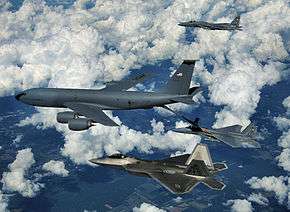

Tyndall Air Force Base is a United States Air Force Base located 12 miles (19 km) east of Panama City, Florida. The base was named in honor of World War I pilot 1st Lt Frank Benjamin Tyndall. The base operating unit and host wing is the 325th Fighter Wing (325 FW) of the Air Combat Command (ACC). The base is delineated as a census-designated place and had a resident population of 2,994 at the 2010 census.[1]
Major units
325th Fighter Wing (325 FW)
The 325th Fighter Wing’s primary mission is to provide a combat ready air dominance force, train F-22A Raptor pilots and maintenance personnel, and train air battle managers to support the combat Air Force. Tyndall's combat mission is performed by the 95th Fighter Squadron. Training for F-22 pilots is performed in the 43d Fighter Squadron and the 2d Fighter Training Squadron. The 325th Air Control Squadron trains air battle managers for assignment to combat Air Force units. Additionally, wing personnel manage the southeastern air combat maneuvering instrumentation range and provide mission-ready F-15, F-16 and F-22 air dominance forces in support of the Commander, North American Aerospace Defense Command (NORAD) and the Commander, First Air Force (1 AF) / Air Forces Northern (AFNORTH) contingency plans.
From 1983 until 2010, training for F-15 Eagle pilots was performed at Tyndall AFB by the 1st, 2d, and 95th Fighter Squadrons. The 1 FS inactivated in 2006, while the 2 FS and 95 FS inactivated in May and September 2010, respectively. During this time, Tyndall also hosted training for F-15C/D maintenance personnel and intelligence officers assigned to F-15C/D units. The 95 FS was reactivated in September 2013 as part of the F-22 Raptor consolidation plan that moved the 7th Fighter Squadron's aircraft to Tyndall. The 2d Fighter Training Squadron was activated in 2014 to perform the T-38 adversary operations in support of the F-22 training mission.
The 325th Fighter Wing is host to more than 30 tenant organizations located at Tyndall Air Force Base, Florida. The wing consists of the 325th Operations Group, 325th Maintenance Group, 325th Mission Support Group and 325th Medical Group.
First Air Force (1 AF)
Headquarters, First Air Force at Tyndall is part of the Air Combat Command (ACC), ensuring the air sovereignty and air defense of the continental United States. As the CONUS geographical component of the bi-national North American Aerospace Defense Command and air component of United States Northern Command (USNORTHCOM), 1 AF also provides airspace surveillance and control and directs all air sovereignty activities for the continental United States.
1 AF primarily consists of Active Guard and Reserve (AGR) and Air Reserve Technician (ART) personnel of the Air National Guard (ANG), augmented by additional part-time "traditional" Air National Guard and Air Force Reserve personnel. Operationally-gained by ACC, 1 AF is the only Numbered Air Force in the Air National Guard and is responsible for all Air National Guard F-15 and F-16 fighter units.
53d Weapons Evaluation Group
The 53d Weapons Evaluation Group (53 WEG), is an Air Combat Command tenant organization that reports to the 53d Wing (53 WG) at nearby Eglin Air Force Base. Among its subordinate squadrons at Tyndall, the 53 WEG manages offshore weapons ranges over the Gulf of Mexico, manages target drone programs ranging from sub-scale target drones to a fleet of QF-4 Phantom II Full-Scale Aerial Targets (FSAT), most of which are converted F-4E and F-4G aircraft. The 53 WEG will also have management of QF-16 as older F-16A and F-16C aircraft are converted to FSATs. The 53 WEG also serves as primary manager for "William Tell," the annual U.S. Air Force Air-to-Air Weapons Meet and competition.
Additionally, all of the Air Force's Air Battle Managers are initially trained at Tyndall prior to proceeding to Tinker AFB, Oklahoma for actual positional training in the E-3 Sentry AWACS aircraft.
The Air Force Civil Engineer Center is also headquartered at Tyndall and a branch of the Air Force Research Laboratory's Materials and Manufacturing Directorate also has facilities at the base.
Reference for major units[2]
History

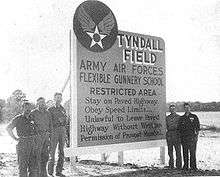
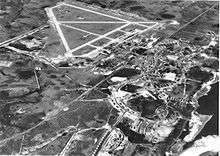
Tyndall Field was opened on 13 January 1941 as a gunnery range. The airfield was named in honor of 1st Lt Frank Benjamin Tyndall (1894–1930).[3] With the establishment of the United States Air Force in 1947, the facility was renamed "Tyndall Air Force Base" on 13 January 1948. In December 1940, a site board determined that Flexible Gunnery School No. 9 would be located 12 miles (19 km) southeast of Panama City, Florida on East Peninsula. On 6 May 1941, Army and local dignitaries held an official ground breaking for the school. Panama City's mayor, Harry Fannin, dug the first spade full of sand, and Colonel Warren Maxwell, Tyndall's first commander, wielded the first ax on the stubborn palmetto plants, so common on the East Peninsula. The site was covered with pine and palmetto trees, scrub brush, and swamps. Bulldozers worked around the clock to clear the brush and fill in swamps.[4]
Although construction was well underway, the base lacked a name. Congressman Bob Sikes suggested naming the school in memory of Lieutenant Francis B. Tyndall. A native of Sewall's Point, Florida, Lieutenant Tyndall was a fighter pilot during World War I and was credited with shooting down six German planes well behind enemy lines in 1918. Lieutenant Tyndall was a World War I pilot, Silver Star recipient, and commander of the 22d Aero Squadron. Lieutenant Tyndall shot down six enemy airplanes in combat over France during World War I. While inspecting Army fields near Mooresville, North Carolina on 15 July 1930, Tyndall's plane, Curtiss P-1F Hawk, 28–61, crashed, killing him instantly. On 13 June 1941, the War Department officially named the new installation Tyndall Field.[4]
On 7 December 1941, the first of 2,000 troops arrived at Tyndall Field. The first class of gunnery students began in February 1942. Although construction was incomplete, instructors and students began preparing for the first class. The first class of 40 gunnery students began on 23 February 1942. Of the thousands of students passing through the Tyndall gates, the most famous was actor Clark Gable, a student here during 1943. Foreign student training began at Tyndall in 1943 with French Air Force gunnery students being the first and Chinese students following later that year.[4]
Cold War
When World War II ended, Tyndall Field was demobilized. The base fell under the control of the Tactical Air Command (TAC) in 1946, but this only lasted three months, as Tyndall became part of the Air University (AU). Tyndall Field was subsequently renamed as Tyndall Air Force Base when the U.S. Air Force became a separate service in 1947.[4]
In September 1950, Tyndall became an Air Training Command (ATC) installation, designated as the USAF Pilot Instructor School. The base also trained Ground Controlled Intercept (GCI) operators as well as interceptor pilots & flight crews for the Air Defense Command. Under the auspices of this training system, GCI trainees would direct TF-51H Mustangs against "enemy" A-26 Invaders. In late 1952, both aircraft were replaced by Lockheed T-33 Shooting Star jet trainers. Airborne radar operator students would begin their training aboard radar-equipped TB-25 Mitchells, then transition to either Lockheed F-94 Starfire or Northrop F-89 Scorpion aircraft. North American F-86F and F-86Ds were eventually added to the training program as Air Defense Command (ADC) units were equipped with them.[4]
In September 1957, Tyndall became an Air Defense Command, later Aerospace Defense Command, base until October 1979 when ADC was inactivated and all its bases and units transferred to Tactical Air Command. Tyndall was headquarters of the ADC 73d Air Division in the late 1950s, and the NORAD Southeast Air Defense Sector from 1960 to 1979. Also the ADC 20th Air Division was based at Tyndall, which was responsible for the air defense of virtually all of the southeastern United States during the 1960s and 1970s. The ADC 23d Air Division, also based at Tyndall, was responsible for air defense forces in the upper midwest and south central United States.[4][5][6]
Fighter-Interceptor base

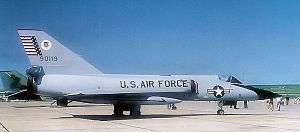
In the late 1950s into the 1960s, the base transitioned into the North American F-100 Super Sabre, F-101B, F-102A and TF-102B, F-104 Starfighter, and the F-106A and B aircraft, training interceptor pilots for ADC assignments. The base served as a stopover and refueling point for ADC aircraft deployed to Florida during the Cuban Missile Crisis, to be redeployed to other bases in the southeast shortly thereafter. The base maintained an alert facility from which the F-101 Voodoo and F-102 Delta Dagger interceptors were scrambled to intercept unknown aircraft. Tyndall shared training for the F-102 aircraft with Perrin AFB, Texas until Perrin AFB's closure in mid-1971.[4]
Radar station
On 1 July 1956 Tyndall AFB became the station operating for the third phase of the ADC mobile radar program, being designated as TM-198. Activated by the 678th Aircraft Control and Warning Squadron, Tyndall became operational to support the CIM-10 Bomarc surface-to-air missile program at Hurlburt Field. In 1958 the site was operating with an AN/FPS-20 search radar and a pair of AN/FPS-6 height-finder sets to support the 4751st Air Defense Missile Squadron.
In 1962 the search radar was upgraded and re-designated as an AN/FPS-64. On 31 July 1963, the site was redesignated as NORAD ID Z-198. During 1965 Tyndall AFB joined the Semi Automatic Ground Environment (SAGE) system, feeding data to DC-09 at Gunter AFB, Alabama. After joining, the squadron was re-designated as the 678th Radar Squadron (SAGE) on 1 June 1965. Also in 1965, Tyndall became a joint-use facility with the Federal Aviation Administration (FAA).
It also received a Back-Up Interceptor Control (BUIC) II, and later BUIC III, capability to perform command and control functions. Tyndall retained this function until the 1980s. On 1 March 1970, the 678th was redesignated as the 678th Air Defense Group.
In addition to the main facility, Tyndall operated two AN/FPS-14 Gap Filler sites:
- Carrabelle, FL (TM-198A): 29°51′57″N 084°37′53″W / 29.86583°N 84.63139°W
- Eglin AFB, FL (TM-198B): 30°33′14″N 086°45′36″W / 30.55389°N 86.76000°W
On 1 October 1979, this site came under Tactical Air Command jurisdiction with the inactivation of Aerospace Defense Command and the formation of ADTAC. On 1 March 1983 the 678th Air Defense Group was inactivated and Tyndall became the home of the NORAD 23rd ADS (Air Defense Squadron) and operated the Southeast Regional Operations Control Center (SE ROCC), later renamed Sector Operations Control Center (SOCC).
The height-finder radar, modified as an AN/FPS-116 c. 1977, was removed c. 1988. In 1995 an AN/FPS-64A was performing search duties. The site now operates an ARSR-4 search radar under FAA control as part of the Joint Surveillance System (JSS) as site "J-11".[4][7][8]
From 1991
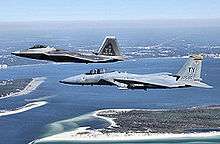
In 1991, Tyndall underwent a reorganization in response to the Department of Defense efforts to streamline defense management. Headquarters, First Air Force, what had predominantly been the Numbered Air Force for the Air National Guard, moved from Langley AFB, Virginia, to Tyndall. With the disestablishment of Tactical Air Command (TAC) in 1992, Tyndall was temporarily transferred to the Air Combat Command (ACC) and then to the Air Education and Training Command (AETC) in July 1993.[4]
The 21st century proved to be momentous for Tyndall AFB. The base was selected as the first home of the Air Force's newest aircraft, the F-22 Raptor. 2002 brought more change as the Chief of Staff of the Air Force changed the organizational structure of the 325th Fighter Wing, from an objective type wing to a combat organization. This organization moved all maintenance activities under the 325th Maintenance Group and all support activities under the 325th Mission Support Group.[4]
Today, Tyndall is the home of the 325th Fighter Wing, providing training for all F-22A Raptor pilots. In 2012, with the gaining of a combat-coded F-22 squadron, Tyndall AFB returned to Air Combat Command, after a 19-year tenure in AETC.[4]
Major commands to which assigned
- Southeast Air Corps Training Center, 16 June 1941
- USAAC Flexible Gunnery School, March 1941
- Air Corps Flying Training Command, 23 January 1942
- Redesignated Army Air Forces Flying Training Command, 15 March 1942
- Redesignated AAF Training Comd, 31 July 1943
- Continental Air Forces, 28 February 1946
- Tactical Air Command, 21 March 1946
- Air University, 15 May 1946
- Air Training Command, 1 September 1950
- Air Defense Command, 1 July 1957
- Redesignated Aerospace Defense Command, 15 January 1968
- Tactical Air Command, 1 October 1979 – 1 June 1992
- Air Combat Command, 1 June 1992 – 1 July 1993
- Air Education and Training Command, 1 July 1993 – 30 September 2012
- Air Combat Command, 1 October 2012–present
Major units assigned
|
|
References for history, major commands and major units[9][10]
Geography
According to the United States Census Bureau, the base has a total area of 14.5 square miles (37.6 km2). 14.5 square miles (37.5 km2) of it is land, and 0.077 square miles (0.2 km2) of it (0.44%) is water.[11]
Demographics
| Historical population | |||
|---|---|---|---|
| Census | Pop. | %± | |
| 1970 | 4,248 | — | |
| 1980 | 4,542 | 6.9% | |
| 1990 | 4,318 | −4.9% | |
| 2000 | 2,757 | −36.2% | |
| 2010 | 2,994 | 8.6% | |
| source:[1][12] | |||
As of the census[13] of 2000, there were 2,757 people, 663 households, and 653 families residing on the base. The population density was 73.1/km² (189.2/mi²). There were 663 housing units at an average density of 17.6/km² (45.5/mi²). The racial makeup of the base was 77.8% White, 14.2% Black or African American, 0.5% Native American, 3.1% Asian, <0.1% Pacific Islander, 2.8% from other races, and 4.6% from two or more races. Hispanic or Latino of any race were 8.3% of the population.
There were 663 households out of which 81.0% had children under the age of 18 living with them, 90.8% were married couples living together, 5.1% had a female householder with no husband present, and 1.4% were non-families. 1.2% of all households were made up of individuals and 0.2% had someone living alone who was 65 years of age or older. The average household size was 3.57 and the average family size was 3.59.
In the base the population was spread out with 37.9% under the age of 18, 17.5% from 18 to 24, 42.4% from 25 to 44, 2.1% from 45 to 64, and 0.1% who were 65 years of age or older. The median age was 22 years. For every 100 females there were 121.1 males. For every 100 females age 18 and over, there were 130.7 males.
The median income for a household in the base was $34,191, and the median income for a family was $33,897. Males had a median income of $25,857 versus $19,821 for females. The per capita income for the base was $11,281. About 3.8% of families and 3.6% of the population were below the poverty line, including 5.3% of those under age 18 and none of those age 65 or over.
See also
- Florida World War II Army Airfields
- 75th Flying Training Wing (World War II)
- List of USAF Aerospace Defense Command General Surveillance Radar Stations
References
![]() This article incorporates public domain material from websites or documents of the Air Force Historical Research Agency.
This article incorporates public domain material from websites or documents of the Air Force Historical Research Agency.
| Wikimedia Commons has media related to Tyndall Air Force Base. |
| Wikimedia Commons has media related to Tyndall Army Airfield. |
- Shaw, Frederick J. (2004), Locating Air Force Base Sites History’s Legacy, Air Force History and Museums Program, United States Air Force, Washington DC, 2004.
- Manning, Thomas A. (2005), History of Air Education and Training Command, 1942–2002. Office of History and Research, Headquarters, AETC, Randolph AFB, Texas ASIN: B000NYX3PC
- This article incorporates text from the Tyndall Air Force Base website, which, as a United States government publication, is in the public domain.
- 1 2 "Profile of General Population and Housing Characteristics: 2010 Demographic Profile Data (DP-1): Tyndall AFB CDP, Florida". U.S. Census Bureau, American Factfinder. Retrieved 15 March 2012.
- ↑ Tyndall AFB website units page
- ↑ "Tyndall". Daytona Beach Morning Journal. Dec 4, 1966. p. 5. Retrieved 3 November 2015.
- 1 2 3 4 5 6 7 8 9 10 11 Tyndall Heritage Factsheet
- ↑ USAF Aerospace Defense Command publication, The Interceptor, January 1979 (Volume 21, Number 1)
- ↑ USAFHRA Organizational Records
- ↑ A Handbook of Aerospace Defense Organization 1946 – 1980, by Lloyd H. Cornett and Mildred W. Johnson, Office of History, Aerospace Defense Center, Peterson Air Force Base, Colorado
- ↑ Winkler, David F. (1997), Searching the skies: the legacy of the United States Cold War defense radar program. Prepared for United States Air Force Headquarters Air Combat Command.
- ↑ Tyndall AFB website
- ↑ Mueller, Robert (1989). Volume 1: Active Air Force Bases Within the United States of America on 17 September 1982. USAF Reference Series, Office of Air Force History, United States Air Force, Washington, D.C. ISBN 0-912799-53-6, ISBN 0-16-002261-4
- ↑ "Geographic Identifiers: 2010 Demographic Profile Data (G001): Tyndall AFB CDP, Florida". U.S. Census Bureau, American Factfinder. Retrieved 15 March 2012.
- ↑ "CENSUS OF POPULATION AND HOUSING (1790–2000)". U.S. Census Bureau. Retrieved 17 July 2010.
- ↑ "American FactFinder". United States Census Bureau. Retrieved 2008-01-31.
External links
| |||||||||||||||||||||||||||||||||||||||||||||||||||||||||||||||||||
| ||||||||||||||||||||
| |||||||||||||||||||||
| ||||||||||||||||||||||||||||||





